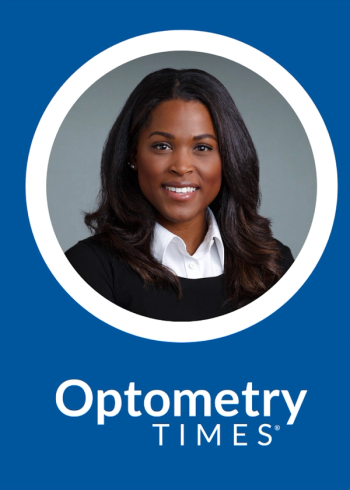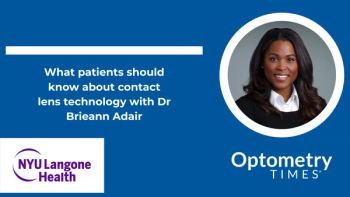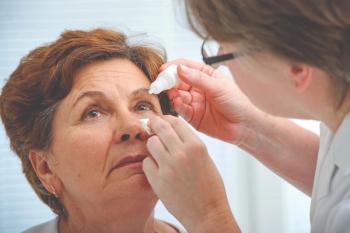
The ins and outs of fitting multifocal contact lenses
Jessica Crooker, OD, sits down with Optometry Times to discuss common pitfalls optometrists run into when fitting multifocal contact lenses and how to avoid them.
Video transcript
Editor's note: This transcript has been lightly edited for clarity.
Kassi Jackson:
Hi, everyone. I'm joined today by Dr Jessica Crooker with Scituate Harbor Vision Source in Massachusetts, who will be diving into multifocal contact lenses with us. Thank you for joining us, Dr Crooker.
Jessica Crooker, OD:
Thank you so much for having me. Happy to be here.
Jackson:
So let's just dive right in. What makes multifocal contact lenses and their uses stand out compared to other lens options?
Crooker:
Sure. I have a lot of patients that are in multifocal. They're actually some of my very favorite contact lenses to prescribe. What's great about them is they kind of give patients the opportunity to lose their reading glasses that they've hated to carry around in their bag. I think it's a great opportunity for patients that maybe have a need for both distance and reading [glasses] to be independent, for most situations, from those reading glasses. I really love that they've come a long way. The lens designs are so unique and comfortable that patients are able to wear them comfortably all day long without having any issues. [They are] able to do their work day and beyond without having any issues.
Jackson:
Wonderful. With all of the presbyopia correcting drops that are emerging, why do you continue to recommend multifocal lenses?
Crooker:
The presbyopia drops are definitely an option for some patients, but I found that they're not the best option for other patients. I think that they're another tool that we have in our toolbox, but the multifocal contact lenses, I found, are just such a great option for anyone. They allow patients to have that freedom of being able to put a lens in at the beginning of their day, whether it be the day starting at 5am or the day starting at 7am, and being able to rely on their vision and the comfort of that lens all day, whether their day ends at five, or their day ends at seven, or 10 o'clock at night if they're going out after work. I really love the flexibility of a multifocal contact lens, and I think it's just a better option for a lot of the patients out there.
Jackson:
You kind of just alluded to this, but how can multifocals be utilized to best empower patients in their care and their treatment.
Crooker:
I have a lot of patients that come in who don't really know a lot about the options that are available to them. A lot of patients will come in [and] this may be their first eye exam since elementary school or since high school. So, they don't know about a lot of the different options that are available. I think once they leave and they know that their options are not just over-the-counter readers [and] that they have some other choices or other selections, they do feel empowered that they're being able to make decisions about their eyes that are working best for them and their lifestyle. I think a lot of patients that come in maybe have been told [they] can't wear contact lenses or contact lenses might not be a good choice for [them]. When you kind of give them the option [where] yes, they are a choice for you, [and] yes, they will be able to help you out for your workday, for your weekends, for fun things like that, a lot of patients feel excited when they leave, like, "finally, I have another option or opportunity to be able to see comfortably without having to rely on things like reading glasses." So, they do leave feeling very empowered.
Jackson:
Awesome. What makes a patient a great candidate for multifocal lenses instead of other forms of presbyopia correction, for example.
Crooker:
I think that most patients are a great candidate for multifocal contact lenses, as long as we have a lenses available in their parameter. We always want to set expectations with contact lenses. I let patients know that the multifocal lenses are going to be great for most situations, [but] there might be some situations here and there where if it's a low light setting or dimly lit settings at work that they might need an extra bit of light or an extra bit of reading glasses. I think that's the most important thing, just letting patients know that this is an option that's available to them. I think that's one of the things I really love about multifocal. The parameters that are available nowadays are so vast that I can fit most patients in multifocal lenses comfortably. I find that patients are really happy with them right off the bat, so it's nice.
Jackson:
That's awesome. Why might optometrists be hesitant to discuss most multifocal lenses with their patients?
Crooker:
I think some optometrists have the notion that multifocal lenses are difficult to fit. I spent a lot of time when I first graduated from optometry school waiting for patients to come into my office. We didn't really have a lot of patient flow when I first started, so I spent a lot of time really getting to know the multifocal fitting guide. I think that was the the main thing that made me such a great multifocal fitter because I follow that fitting guide to a tee. I think that if optometrist kind of learned that okay, here's my lens of choice, my multifocal lens of choice, here's the fitting guide, I'm going to follow that exactly, and not deviate from the course of the fitting guide. I think a lot of people would find that multifocal 's are actually quite easy to fit. There's that idea that multifocal is are a difficult thing to fit and take a lot of chair time. But, I think if you follow that fitting guide, you'll see that they actually are pretty easy to fit.
Jackson:
Yeah. Can you tell us about the fitting process for multifocal lenses that you follow in your practice? Do optometrists need to have any specific tools in their practice to successfully fit for these lenses?
Crooker:
Sure. I love to fit multifocal. I had 2 patients just before I jumped on here that I just fit with multifocals for the first time. I think the the most important thing is you always want to start off with a fresh refraction. Get their prescription today, that's starting off on the right foot. I find that some doctors who fit multifocal will use an older prescription or use a prescription from a year ago. I think that's starting yourself off on the wrong foot. You want to have that fresh prescription, [then] go from there. I really love to use the Alcon multifocal lenses. My favorite ones have always been the Dailies Total 1 multifocal lenses. I find that they work really well [and] that following the fitting guide really makes it an easy lens for me to fit. My patients really appreciate and love the comfort of those lenses. I think one of the important things to have are some flippers, and you can show the patients the difference between adding and subtracting plus a quarter power and plus 50 power. I think it makes a good experience for the patients there. You really don't need too much. You just need to follow the fitting guide, that fresh refraction, and use the flippers. We always say we're going to push the plus. What that's going to do is help to get a patient into a lens power that's appropriate for them. I really try to get patients excited about the lens, too, [and] excited about the opportunity to be able to see. I'll just usually have them take out their phone and look at something on their phone really quickly. It's amazing how people get so excited when they're first able to see that phone or being able to see something up close for the first time with a multifocal contact lens. Something like that's a good way to leave them and have them head off on their way and test out the lenses on their own.
Jackson:
So building off of that, what role has fitting for multi[focal] contact lenses played in your practice? Has this changed your business model?
Crooker:
Yes, definitely. When I first started, there were certain days where I'd be here for 8 hours a day, and I'd have 4 or 5 patients on my schedule. I think that really inspired me to kind of figure out where my specialty here at this office. Where can I be most beneficial to my patients? I started looking into things like multifocal lenses that the other doctor that I was working with really didn't fit a lot of. I started really understanding that fitting guide, started fitting more and more patients, and getting more familiar with that fitting guide. I found that my part of the business really took off. I'd see 1 patient and she'd go back to her son's soccer team and say, "look, I don't have my glasses anymore." All of a sudden, I was getting referral after referral after referral of patients who maybe didn't even know about multifocal contacts or didn't even know that that was available to them. That it really inspired me to help out as many patients as I possibly could. I thought that this was maybe something that I could develop as my specialty at the office, and it really has grown my business immensely. I purchased my practice in 2017. At the time, there was 1 full-time doctor and I was working part-time at this office here. Wow the office is booming. I mean, we're booking out several months. I have 4 doctors, and we're open 12 hours a day, Monday through Friday, eight to eight. A lot of it is our multifocal business, and a lot of it is referrals that we'll get from a whole soccer team or a whole group of soccer moms or soccer dads. I think it's just completely changed how I've decided to focus on treating my patients. It's no longer that we just say, here's the option of over-the-counter readers, it's being able to provide patients with an opportunity to try something different and something that they may have never heard of before. It really has just made my business grow immensely.
Jackson:
That's really exciting to hear, especially with seeing it bloom and kind of bursting at the seams. That's exciting.
Crooker:
Yeah, running out of space, actually.
Jackson:
That's a good problem to have. So, why is this conversation important for optometrists and eye care professionals to have?
Crooker:
I think that presbyopia is kind of a touchy subject for a lot of people, especially for people that are maybe in their early 40s that are just starting to experience this. Nobody wants to feel like they're getting old and nobody wants to feel like their eyes are weaker than ever before or anything like that. It's important to approach the subject in the appropriate manner, and I think it's important to be able to have a solution for your patients as well. That's the most important thing that I think of. If I have a patient that it's their first time in, and I can tell that they're really upset and what we hear a lot of patients say [is], "I woke up this morning, and all of a sudden, I couldn't see up close." They're upset, they're nervous, they're sometimes a little bit scared. It's just having that conversation with them that there's different ways that we can treat it, there's options for you out there. I think it makes a lot of patients feel more comfortable. I could see them in the chair, their stress starting to be relieved, as they start to hear that there's more options for them. I think that's one of the things that makes fitting multifocal so special for me. [You] really can change how somebody feels, how they feel about their eyes and their vision, and aging even.
Jackson:
Yeah, and you kind of just touched on this, but how does this affect patient care?
Crooker:
I see a lot of new patients who have never had their eyes examined before, and they're 50 years old. Or, maybe they had their eye exam 20 years ago. A lot of those patients come in and they think that with presbyopia all of a sudden it can't see up close, there's something wrong with me. There's a sign that there's a tumor or I have something horrible going on. Once you kind of give the patients that time and attention, and let them know [that] this is normal, this is something that we can help you with, you can definitely see that patients just instantly relax. They know, okay, somebody's here, somebody's able to take care of me. That feeling is priceless for me. It always makes me feel good to have patient leave, and they say, "I feel so much better than when I came in here." So it really does affect how patients interact.
Jackson:
That's amazing. I'm sure that helps them come back to you and feel just better about their care overall.
Crooker:
Definitely.
Jackson:
Is there anything else you'd like to be sure to touch on that we didn't talk about?
Crooker:
I would say for most eye care professionals, fitting multifocal is amazing. If people are nervous about trying, I think just give it a chance to really get in there [and] start working with them. You'll see that there are many opportunities for growth in the practice, if you get in there and get started with them. So, it's great opportunity.
Jackson:
Wonderful. Well, Dr Crooker , thank you so much for your time today.
Thank you so much.
Newsletter
Want more insights like this? Subscribe to Optometry Times and get clinical pearls and practice tips delivered straight to your inbox.













































.png)


